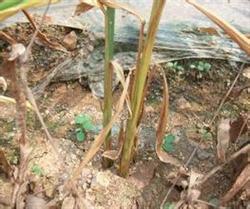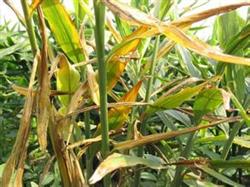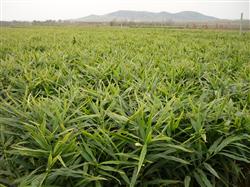Control of Ginger Stem Rot

In recent years, with the continuous expansion of ginger continuous cropping area and extensive field management, the disease of ginger is also aggravating, especially since June, because of high temperature and rain, ginger stem rot is the most likely to occur. Recently, Li Hualiang and Lu Changlei in Renzhao Town, Pingdu City, Shandong Province, and Yu Wanquan in Ju County reflected that the ginger they planted there had begun to develop stem rot, looking for good control methods. The symptoms of ginger stem rot are introduced as follows: first, in the early stage of the onset of ginger stem rot, water stains of different sizes appeared at the base of the stem, gradually expanded, the leaves yellowed, and the disease spot surrounded the base of the stem for a week in the later stage of the disease, resulting in the gradual decay of the tissue at the base of the stem. Due to the obstruction of water and nutrient transport, the aboveground main stem withered and died from top to bottom, and the leaves blackened and fell off. When the humidity was high, white cotton floss could be seen in the diseased part and soil, and when it was serious, the plant began to die, causing great harm. 2. the pathogen can overwinter with mycelium lurking on diseased ginger and diseased body, or overwintering with mycelium and chlamydospore in soil under suitable conditions. Generally, it began to occur in May, and the ginger seeds with germs can continue to suffer from the disease after harvest and continue to be sown in March of the following year. 3. High temperature and humidity are beneficial to the occurrence of ginger stem rot, and the suitable temperature is 20 ℃-25 ℃. Ginger is a light-loving and drought-tolerant plant, and plots with poor ventilation and light transmission are prone to disease. The disease was serious in yellow loam and heavy clayey soil. The sandy loam soil with deep soil layer, good drainage, loose soil and rich organic matter should be selected, and the soil pH value should be 6-7. Phosphorus and potassium fertilizer can effectively promote the growth of ginger and improve disease resistance. The pathogen can survive in the soil for a long time, and the amount of bacteria in the field of continuous cropping plot is accumulated, and the disease is more serious. Fourth, prevention and control measures 1. Choose disease-free and mildew-free ginger to prevent the spread of diseases and pests and ensure that the whole seedling is strong. When sowing, soak the seeds with 8000 times of Fuxing EC, or soak the seeds with 100kg of carbendazim for 4-5 minutes, dry and wait for sowing. two。 Soil disinfection treatment. In the plots with serious disease, 70% topiramate, 50% carbendazim, 50% dimethazone or thiram 1-1.5 kg mixed with fine soil and 30 kg per mu of soil are selected for soil preparation. Disinfection with lime in acid soil can prevent soil-borne diseases. 3. Reasonable crop rotation. Rotation with Gramineae crops for more than 2 years to prevent disasters and avoid disasters. 4. Use fertilizer scientifically to improve the soil. Ginger likes the soil with good air permeability. 100kg potassium sulfate no-tillage fertilizer and 2500 kg mature soil fertilizer, 1kg boron and 1.5kg zinc can be used per mu. 5. Ridge cultivation can improve soil ventilation and promote the growth of underground stems. The ridge is made according to 1 meter width, and the ridge height is 20 cm. When the seedling height is 30 cm, a herringbone frame is built according to 4 bamboo poles per square meter to promote ventilation, light transmission and moisture flow, promote leaf photosynthesis, prevent and control diseases. 6. At the initial stage of the disease, we can also use 8000 times of Fuxing EC and 1000 times of chlorothalonil to irrigate the roots of the diseased site with 50-100ml per plant, once every 10 days, and twice continuously.
- Prev

Management measures of post-autumn ginger
In recent years, with the continuous expansion of ginger continuous cropping area and extensive field management, the disease of ginger is also aggravating, especially since June, because of high temperature and rain, ginger stem rot is the most likely to occur. Recently, Li Hualiang and Lu Changlei in Renzhao Town, Pingdu City, Shandong Province, and Yu Wanquan in Ju County reflected that.
- Next

The technique of "four changes" is skillful in planting warm spring turmeric
In recent years, the situation of earning foreign exchange from the export of high-quality turmeric is good, but the demand for quality is getting higher and higher. Our department instructs 20 big growers to promote the use of the new technology of "four changes", so that the big ginger produced is obese, the skin color is shiny, the average yield per mu is 64% higher than that of traditional planting, and the income of ginger farmers has doubled. When the spring flowers bloom from March to April.
Related
- Where is it suitable to grow horseradish in China? it is expected to see the middle altitude horseradish in Alishan.
- How to prevent tomato virus disease reasonably? (Control methods included)
- Many people like to plant towel gourd on the balcony. What are the main points of this method and management?
- What crops can chili peppers be mixed with?
- Fertilization techniques and matters needing attention in Tomato
- What are the grafting techniques for peach seedlings in spring?
- Harm and control methods of root swelling disease of Chinese cabbage
- What are the pests of sweet potatoes? How to prevent and cure it?
- Symptoms, causes and Control methods of navel Rot in Tomato
- The cause of "Cucumber rotten bibcock" in Farmers' planting Cucumber and its Control Plan

